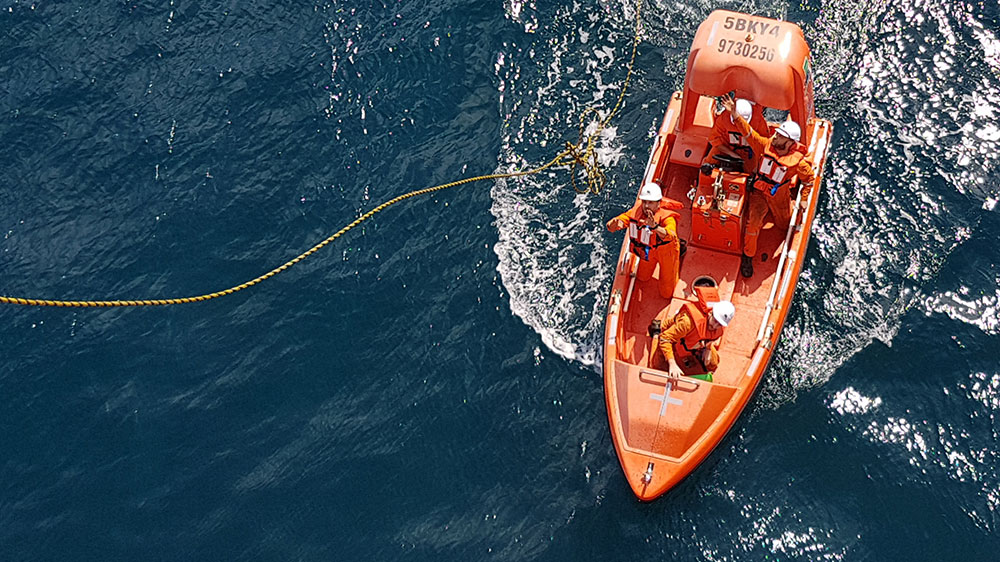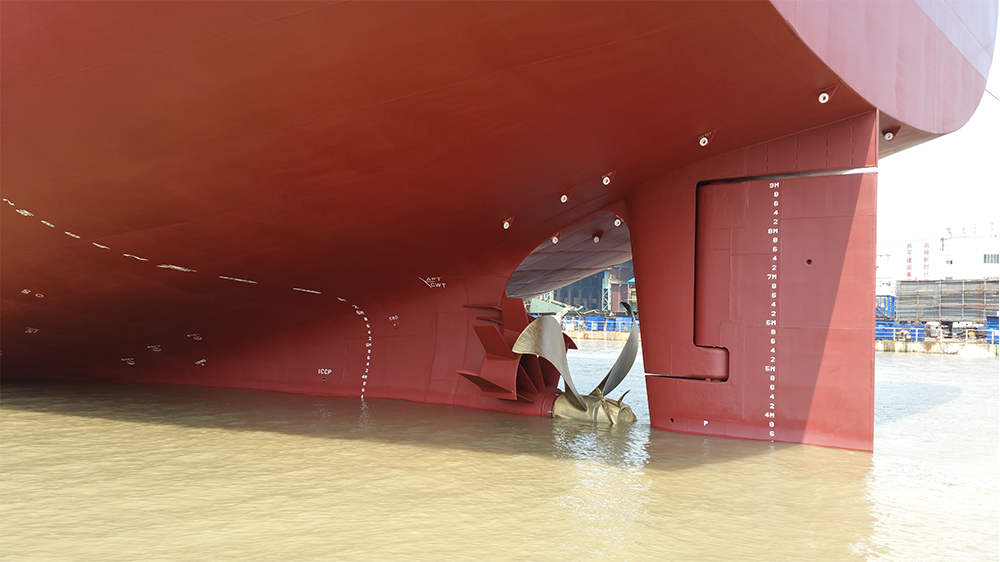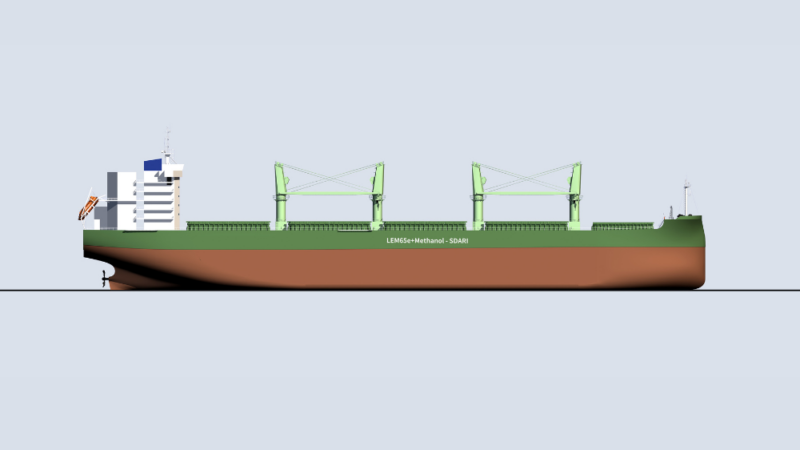11 reasons
our LEM fleet
means ECO.
our LEM fleet
means ECO.
Our vessels give us the comfort of having more than 20% lower operating expenses (OPEX) and over 12% earning potential when bench marked with similar class bulk carrier vessels operating today.
We design our vessels to be top of the line in their respective categories (class); this is an important step in our common pursuit to create a more sustainable shipping concept combined with a flexible design to offer our customers better business solutions at competitive freight per ton-mile.
We left no stone unturned in analyzing our Lem59 design and turning it into a mega successful Lem65 super eco Ultramax.
Joining forces with SDARI & ABS we utilized all means technologically available to optimize the hull lines, propulsion system, cargo intake, engine room, deck cranes and accommodation design.
CFDs, model tank tests, scenario assessments, ESD combo trials and experts’ opinions contributed to the development of an EEDI Phase 3 compliant fleet well ahead of its time.
Other elements of both LEM designs include a distinctive bow shape to maximize the efficiency of the hull. The ship’s hull has also been refined for excellent fuel efficiency under all conditions, from shallow to full load draft.
In our recent LEM65 designs proprietary technology was also used to reduce wind resistance by as much as 20 percent, including the shape of the accommodations block was molded to reduce wind resistance.
We can confidently say that our commitment to pioneering innovation and sustainability excellence gives us an important advantage when new environmental regulations come into play.
All features for operating efficiency onboard our eco fleet ensure that the vessels meet the Energy Efficiency Design Index (EEDI) the International Maritime Organization (IMO) presented to ensure that new ships are designed and built to comply with CO2 reduction.
The EEDI of our LEM65 vessels can meet Phase 3 requirements, which are 30 per cent below the IMO reference line for bulk carriers.
The EEDI of our LEM59 vessels currently meet Phase 2 requirements (and can almost meet Phase 3 requirements – with minor upgrades).
These results demonstrate our commitment to intelligently scale up our fleet in line with customer demand, while aiming for minimum environmental impact.
Since delivered, our eco fleet includes the most fuel-efficient vessels compared to their respective piers at sea.
Our eco fleet consumes apprx. 35% less compared to similar and older generation bulk carrier vessels.
For the best consumption on the market today, we employ various technologies to achieve maximum fuel economy, including an energy-saving, electronically-controlled main diesel engine, a bow designed to reduce wave resistance, high propulsive efficiency propellers, as well as the rudder bulb system with fins and semi-duct system with contra fins.
The goal here is to improve operations while also maximizing every usable space for cargo.
Ahead of all competition for improved efficiency, in 2015 we unveiled a new design – our LEM59 Supramax bulk carrier.
At the time, our LEM59 vessels had the largest carrying capacity in class of Supramax bulk carriers for a vessel that also meets the Panamax breadth.
In 2018, we repeated the redesign process, this time in the Ultramax sector and unveiled another new design – our LEM65 Ultramax bulk carrier making it the largest carrying capacity in the class of Ultramax bulk carriers permitting it to maximize transportation efficiency.
Stay tuned as we continue to outperform ourselves and the boundaries with our new LEM65e+.
All of our fleet has been equipped with a sophisticated vessel performance monitoring system.
The system allows us to collect real-time information on the performance of important equipment, with a particular focus on vessel performance and fuel consumption. We designed the system to enhance our operational knowledge and increase the efficiency of our trading and of our vessel maintenance.
Using real-time data collected from the system and in-house analysis, we can:
- evaluate optimum operating parameters during various sea passage conditions;
- compare actual versus required vessel performance and fuel consumption;
- assess and evaluate vessel and equipment actual performance;
- take proactive steps, if needed, to ensure vessel and equipment operate in a reliable and efficient manner;
- minimize downtime and off-hires by proper planning and selecting the right timing for maintenance through the condition-based monitoring approach;
- identify timely potential operating problems; and
- ensure that our seafarers are well informed and taking necessary actions to reduce the likelihood of a malfunction.
With KeelX Analytics (Lemissoler spin-out) we leverage technology to reap environmental benefits for the planet and economic gains for our fleet.
KeelX Analytics Eco Suite helps us monitor and analyze the performance of our ships and plan AI-driven optimal voyages.
We joined forces with MASADA China and MITSUBISHI Japan to co-develop all-electric cargo deck cranes. The outcome of this extensive collaborative effort is tremendously satisfying with all our Lem65 newbuilding’s featuring the cranes.
We continuously collect and analyze data from operations with the aim to advance the design further along with wider industry technological advancements.
Evidence shows reduced energy consumption, faster operations, zero risk of oil pollution, and easier handling vs conventional cranes.
After thousands of model tank testing simulations, these are the energy saving devices we choose to have installed on our fleet to improve even further on already optimal ship design:
-
- Pre-swirl device: Duct, is a propulsion improving device that creates optimal inflow for the propeller by guiding one side of the stern flow in the opposite direction to the propeller rotation, generating pre-swirl. This device directs the flow of the water to the propeller for more effective flow so that the propeller will provide the best possible thrust with the least effort. This can give efficiency improvement between 3-7%.
- Post-swirl device: Hub Vortex Absorb Fins, is an energy saving propeller cap with fins that rotate together with the propeller. This is a small propeller type device which is fitted on the end of the propeller boss and smoothness the vortex created by the propeller, thus reducing the drag. The efficiency improvement is between 2-5%.
- High-Efficiency propeller: Kappel propeller, is similar to that of the wing let at the end of airplane wings, with the suppression of the tip vortex permitting high blade loading in this region. The minimized flow over the blade tip and the outer region of the Kappel propeller geometry retain high efficiency – increasing the total efficiency of the Kappel propeller compared to conventional propellers. This can give efficiency improvement between 3-10%.
Here too we pushed the boundaries and equipped our vessels with the grabs with optimized curves to get the most amount of cargo in as possible per lift.
Our deck cranes have been fitted with a highest volume grabs (compared to conventional deck cranes of similar size vessels) so that vessel loading and unloading time lapse is minimized.
The weight of the grabs themselves is minimized due to design patents, computer-aided design tools and finite elements analysis optimization — in this way, grab capacity can be increased for a certain crane lifting capacity.
A new ongoing cycle of innovation starts from the moment our newbuildings sail away from the shipyard for their maiden voyage.
Our entire fleet is equipped with real time sensors installed on-board so our on-shore team can perform continuous vessel performance analytics.
This in addition to our ever-expanding network of emerging technology providers enables us to model potential savings in fuel and CO2 by incorporating new technologies on board our upcoming Lem65e+ design.





